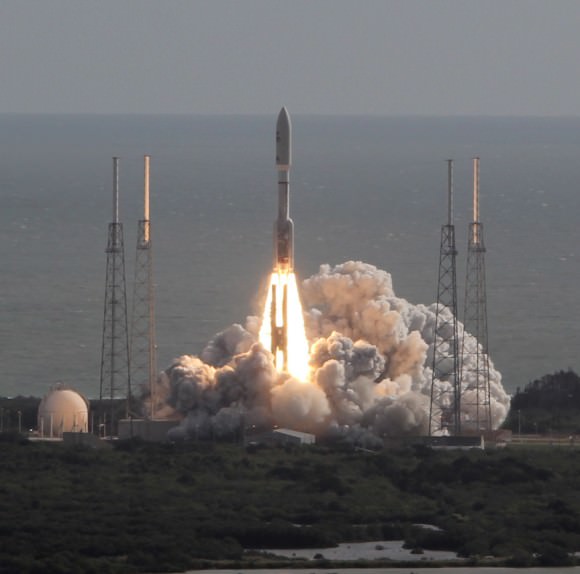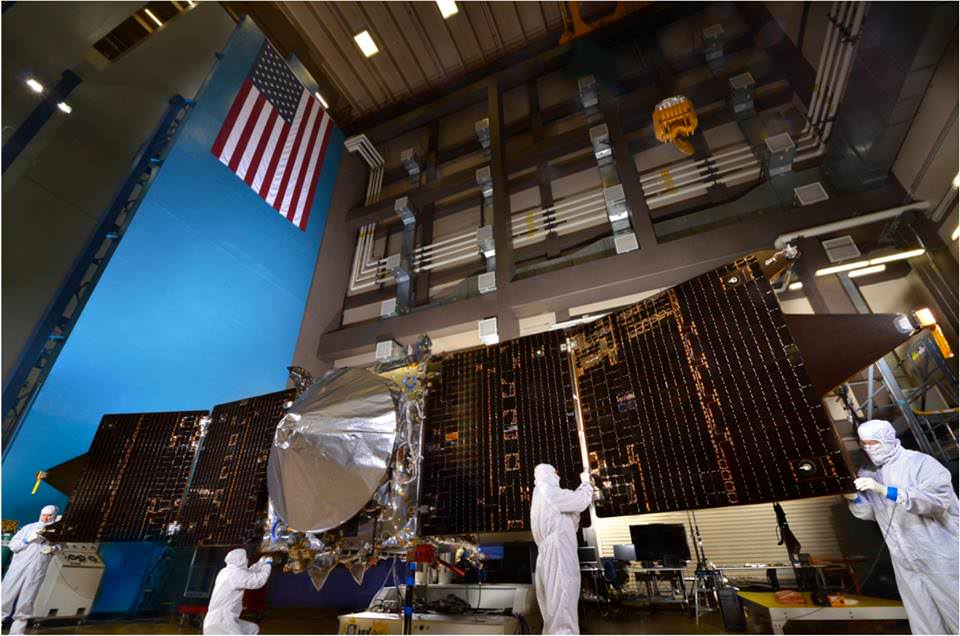The solar panels on NASA’s MAVEN Mars orbiter are deployed as part of environmental testing procedures at Lockheed Martin Space Systems in Littleton, Colorado, before shipment to Florida on Aug. 2 and blastoff for Mars on Nov. 18, 2013. Credit: Lockheed Martin
Watch cool testing videos below![/caption]
MAVEN is NASA’s next mission to Mars and in less than three days time the spacecraft ships out on a cross country trek for the first step on the long sojourn to the Red Planet.
But before all that, technicians took MAVEN for a final spin test, flexed her solar arrays and bombarded her with sound and a whole lot more.
On Aug. 2, MAVEN (Mars Atmosphere and Volatile EvolutioN Mission) journeys half a continent from its assembly facility at Lockheed Martin in Littleton, Colorado to the Kennedy Space Center and the Florida Space Coast aboard a USAF C-17.
Unlike Curiosity, which is roving across a crater floor on the Red Planet at this very moment, MAVEN is an orbiter with a first of its kind mission.
MAVEN is the first spacecraft from Earth devoted to investigating and understanding the upper atmosphere of Mars.
The goal is determining how and why Mars lost virtually all of its atmosphere billions of years ago, what effect that had on the climate and where did the atmosphere and water go?
To ensure that MAVEN is ready for launch, technicians have been busy this year with final tests of the integrated spacecraft.
Check out this video of MAVEN’s Dry Spin Balance Test
The spin balance test was conducted on the unfueled spacecraft on July 9, 2013 at Lockheed Martin Space Systems in Littleton, Colorado.
NASA says the purpose of the test “is to ensure that the fully integrated spacecraft is correctly balanced and to determine the current center of gravity. It allows the engineering team to fine-tune any necessary weight adjustments to precisely fix the center of gravity where they want it, so that it will perform as expected during the cruise to Mars.”
It was the last test to be completed on the integrated spacecraft before its shipment to Florida later this week.
This next video shows deployment tests of the two “gull-wing” solar panels at Lockheed Martin Space Systems.
Wingtip to wingtip, MAVEN measures 11.43 m (37.5 feet) in length.
In mid May, MAVEN was moved into a Thermal Vacuum Chamber at Lockheed Martin for 19 days of testing.
The TVAC test exposed MAVEN to the utterly harsh temperatures and rigors of space similar to those it will experience during its launch, cruise, and mission at Mars.
MAVEN is slated to blast off atop an Atlas V-401 rocket from Cape Canaveral Air Force Station, Florida on Nov. 18, 2013. The 2000 pound (900 kg) spacecraft will be housed inside a 4 meter payload fairing.
After a 10 month interplanetary voyage it will join NASA’s armada of four robotic spacecraft when it arrives in Mars orbit in September 2014.
Scientists hope that measurements from MAVEN will help answer critical questions like whether, when and how long the Martian atmosphere was once substantial enough to sustain liquid water on its surface and support life.
“What we’re doing is measuring the composition of the atmosphere as a measure of latitude, longitude, time of day and solar activities,” said Paul Mahaffy, of NASA’s Goddard Space Flight Center in Greenbelt, Md, and the principal investigator for MAVEN’s mass spectrometer instrument.
“We’re trying to understand over billions of years how the atmosphere has been lost.”
…………….
Learn more about MAVEN, Cygnus, Antares, LADEE, Mars rovers and more at Ken’s upcoming lecture presentations
Aug 12: “RockSat-X Suborbital Launch, LADEE Lunar & Antares Rocket Launches from Virginia”; Rodeway Inn, Chincoteague, VA, 8 PM
Oct 3: “Curiosity and the Search for Life on Mars – (3-D)”, STAR Astronomy Club, Brookdale Community College & Monmouth Museum, Lincroft, NJ, 8 PM



MAVEN should have been called VAVEN and sent to Venus instead.
There is pretty much nothing left of Mars atmosphere and the whole exercise is futile. Venus on the other hand has the distinct possibility of biological life in the upper atmosphere thanks to the dense atmosphere which supplies all the nutrients needed for life to flourish.
Great news and clips, go MAVEN! Cheers